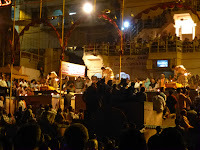On my recent trip to India, I was planning to travel a bit within India and as it so happened my parents were also planning a trip to Kumbh. The
mela was about to end soon, and just by chance, I got to be a part of this almost historical happening!
My parents had stayed in Allahabad from 2003 to 2005 and I had already taken a dip many times at the Sangam but never during a Kumbh Mela. I had always wished to experience Kumbh and when the whole trip fell into place, you can imagine how happy I would have been:)!!
 |
| Bridge on river Yamuna |
The Kumbh
melas are held every 12 years in Allahabad and it is supposed to be very auspicious to take a dip in the holy Sangam during this period. The Sangam is the name given to the confluence of 3 holy Indian rivers in Allahabad; of Ganga, Yamuna and the invisible Saraswati.
 |
| Kumbh arrangements |
This Kumbh was bigger than usual as its after 148 years that it is so auspicious (as Hindu mythology says..). Apparently 10 crore (100 million) people took a dip in the river this year during Kumbh with one day seeing almost 3 crore people taking a holy dip!! The number boggles the mind, and is an impressive feat I would say. (Now I understand why in the Hindi movies of yore, children would get separated from their parents during Kumbh and then meet again after 12 years!)
The Kumbh had been going on for more than 2 months and I had seen enough photos about the Kumbh to know what to expect. (And I had seen and read enough of the Naga babas also to know what to avoid!) It appeared to me that the Naga babas come out of hiding only at the Kumbh. I wonder where they are the rest of the year?
 |
| Akbar's Fort at Sangam |
As for me, I would say that I had a very posh and short experience at the Kumbh. We stayed in the army area and took a boat from Saraswati Ghat to take us to the Sangam area. We went via the Yamuna which has greenish and calmer waters. In Allahabad, the Yamuna is deeper and carries more water than the Ganga, hence its not easy to boat on the Ganga. The location where the Ganga and Yamuna meet, is the location of Akbar's fort. So as we rode in the boat along the Yamuna, we could see the fort on one side. The other had rows and rows of tents for people to stay in during Kumbh.
 |
| Towards Sangam |
The river looked divine in the morning, with rows of boats all making a beeline for the Sangam and the water shining in the morning sun.
|
|
| Boats going towards Sangam
|
Once we got closer to the spot, we could see the thousands of people - the perfect picture for colourful and incredible India - waiting to take the holy dip. It just felt like a sea of humanity on the shore.
 |
| Sangam |
We all took the dip slightly away from shore, the spot where the two rivers meet and the water is shallow as a lot of sand is deposited there to make it easier for pilgrims to take a dip. The colour of the water changes when the shallow and faster moving Ganga meets the calmer and deeper Yamuna. According to Hindu mythology, Yamuna is the elder sister, and hence maturer and deeper while Ganga is the younger immature (
chanchal) sister. This might have its roots in what is visible in the flow of the two rivers where they meet.
The arrangements at Sangam were quite impressive and I can imagine how much planning would have gone into making a meet of 10 crore people successful. We also got a view of the
mela from the control room. This is the view of a part of the spread of the
mela around the Sangam site. The tents were spread wide and afar, on the other side of the Ganga and Yamuna and the Kumbh grounds; basically for kilometers till where the eyes could see, all we saw were tents! These tents were setup by religious
gurus, each with their own sets of devotees and running their own spiritual discourses during the day.
 |
| The Kumbh grounds |
 |
| Akshay Vat |
After the dip, we visited the Akshay Vat tree which is located inside the fort and is said to be the tree under which Ram, Sita and Lakshman had rested during their 14 years exile. We also visited the Saraswati Koop; a temple for Saraswati with a well which supposedly contains water from the invisible Saraswati river. Its a sad sight to see guards sitting around the well making sure people don't throw all kinds of things into the well and choke it like had happened some years earlier.
Another famous
mandir to visit in Allahabad is the Hanuman Mandir which is the only temple where Hanumanji is shown sleeping. In this temple, his statue is lying on the ground rather than standing which is the most popular portrayal. And it is said that every year when the level of water in the Ganga rises, it floods the river plain and rises upto Hunamanji's feet and then recedes. As if Ganga touches Hanumanji's feet every year. How lively is Indian mythology? Explaining and linking so many stories together, its always an interesting experience to learn about it more and more..
Other than that, visitors to Allahabad can also visit the Anand Bhawan which is the ancestral home of the Gandhis (erstwhile Nehrus) and now houses a museum.
From Allahabad, we left by road for Banaras, which is one of the most holy Hindu cities, the Kashi or Varanasi of old.
On the way, you can see why UP has the highest population in India. There is not a patch of land devoid of human habitation. There are villages all the way to Banaras.
You can also see how much handicraft there is in UP. There are villagers sitting next to the roads selling their crafts. Most noticeable of these were around the village of Bhadoi; multiple shops next to the highway selling hand made carpets. How much I wish these handicrafts do not die off due to lack of patronage!
|
|
| Boats going towards Sangam
Devotees
|
Banaras is an experience of its own, something I have not seen elsewhere in India either. The first evening in the city, we went to see the daily Ganga
aarti that takes place in the evening at 6:45pm on the banks of Ganga. The
ghats are all located in the old part of Banaras with crowded roads you can't even imagine. Maybe it was because of the Kumbh, but the city was full of people. It was easy to become overwhelmed and get lost in the sea of humanity on this old part of town. I was therefore even more amazed at how easily and comfortably some foreigners were in a place like this when even Indians might feel out of place.
 |
| Ganga near the ghats |
 |
| Ganga near the ghats |
The
aarti is conducted in a grand ceremony by six young
pandits on the banks of the river, with thousands of people watching from behind the
aarti or from the boats. Its a 45 mins long prayer and an experience in itself. And on the banks, people were floating lighted
diyes wih flowers in the river, all the
diyas making for an interesting sight, hundreds of lighted lamps glittering in the water. It was a fascinating sight, which I could not have captured on my camera.
|
|
| The crowds near the aarti |
sitting on the banks, smoking and just lazing around. There were many foreigners also sitting with them, just smoking and doing nothing else. Frankly, the Naga
do not seem spiritual or holy at all. I wonder who they are and what they believe in? Also I must mention, even though Banaras is a holy city, its lack of cleanliness takes a lot away from the spiritual and religious feeling it should emanate. This was the feeling I had the last time I had visited and it was the same even now. Sad...
at the Kashi Vishwanath temple. which is one of the 12
temples in India. Its a highly revered place of worship for devotees of Shiva and visited by almost 3000 people every day. The temple complex is small with the main temple covered in gold. The
happens at 2 am in the morning and you can get a view of this only if you have a VIP pass. Its a one hour long
with honey, milk and water and then decorating it with flowers.
with another 50 fighting to get even a glimpse of it. All I remember of my time at the
is just all the people pushing each other and arguing with each other trying to get a view of the
. Is this religion? Is this holy? Is this what God wants?
Unfortunately this is the lasting impression I had got the last time I had been to Kashi Vishwanath temple and it remains unchanged even now.
opens it gets even worse, people fighting to get ahead of each other as if an earlier view of the
is going to increase their life by 10 years! On top of it, the policemen posted inside the temple also start showing their power by shoving and shouting at people.
This is definitely not what spiritualism means for me and I for one cannot understand this kind of devotion. The visit to one of the most holy of Hindu temples marred by this kind of experience is not one that I look for. And this is my experience when I got a VIP entry without having to wait in the line. I don't even want to imagine what it would be like to wait for 5-6 hours in a queue for a view and then having to deal with all the pushing and shoving. After the Vishwanath temple, we also prayed at the Annapurna and Kaal Bhairav temples which are also part of the holy temples of Banaras.
And the rest of the day was spent in buying Banarsi sarees. I as always fell in love with the exquisite work and could not decide what to buy and what not. In the end I picked up 6 sarees! What inspired me to go on this shopping spree was the thought that these works of art may not be available in a couple of years. Even now we had to wait for hours before we could even see a couple of sarees of the intricate
work! They are just so intricate, its difficult to decide what to buy and what not.
After the shopping it was time to say goodbye and I was back in Delhi. On the whole it was an interesting trip, exploring the pilgrimage places of India and I was actually impressed with the number of young people interested in going to Kumbh. I would have thought most people from our generation would not be interested but I was pleasantly surprised with the numbers; heartening to know that some traditions of our culture might even survive the next generation.





















No comments:
Post a Comment